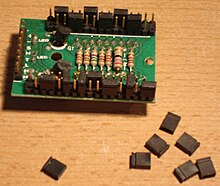Turbo button
The turbo button provided in PCs of 8086 - up Pentium -1 era for a change of clock frequency to be able to control the computing power. Optionally, the full computing power could be used or reduced by reducing the clock signal (mostly to half or a third of the normal clock, often to the frequency of the ISA bus ), but also by means of auxiliary measures such as switching off the level 1 Cache or a reduction in the clock frequency of the front side bus .
This key was introduced with the 8 MHz version of the IBM PC in order to be able to throttle it to the original 4.77 MHz. It happened that some older games ran too fast on modern computers at the time or that delay loops were processed too quickly. The turbo button initially provided a remedy here; on faster computers (from the Intel 80386 as processor) that didn't help either, since the computer was significantly faster than the original IBM PC even in slow mode. Starting with the Intel Pentium , the turbo key became uncommon.
Mechanically, the button is usually designed as a latching switch. The socket for the connection to the main board is three-pin, but the connector on the main board is partly two-pin. Then the plug direction decides at which switch position the turbo is activated or deactivated. Some 286 motherboards also offered several switchable clock frequencies, for example 6-8-10-12 MHz, which were switched through by pressing a button several times .
Most computers at that time were also provided with a two- or three-digit seven-segment display on which either the current clock frequency of the CPU was displayed as a number or the abbreviation "LO" ( low clock ) or "HI" ( high clock ) . This display was not linked to the actual clock frequency, but predefined display patterns were selected for each switch position. The respective patterns to be displayed could usually be configured by jumpers in the display unit.
The turbo button was also retained in later models for marketing reasons: the turbo button suggested a "turbo mode" that promised the appropriate speed. This was supported by corresponding frequency displays, which did not show the actual clock frequency, but a comparison frequency determined by benchmarking , which was significantly higher than the actual frequency and was generally not very meaningful. The key was usually no longer necessary; the computers usually stayed in turbo mode for a long time.
The turbo button can be switched during operation.

